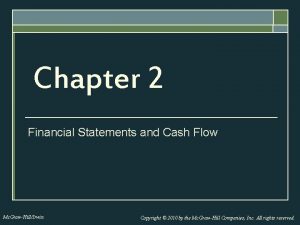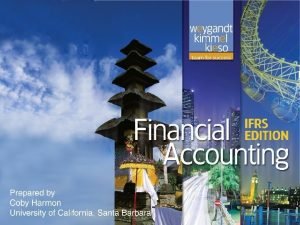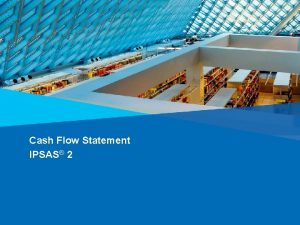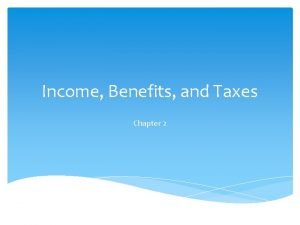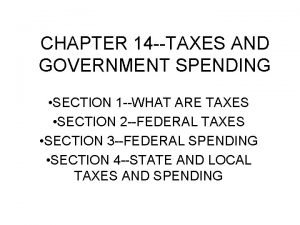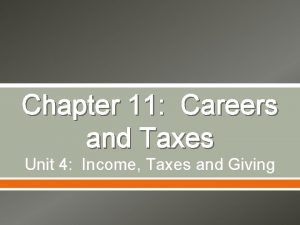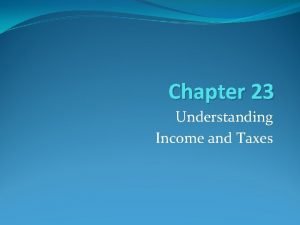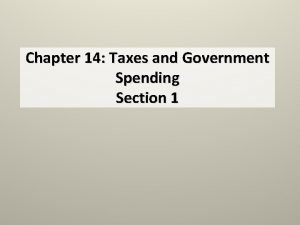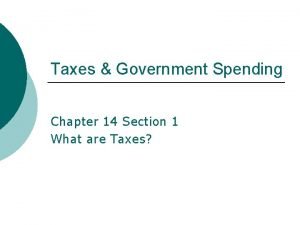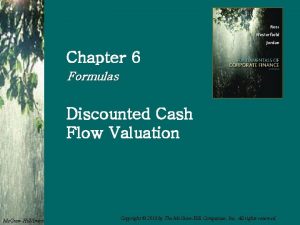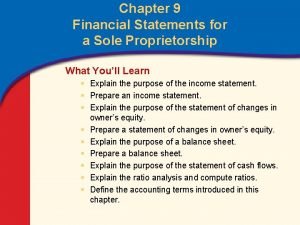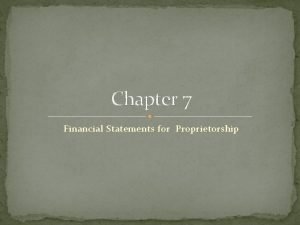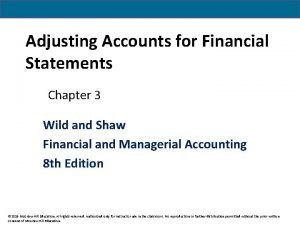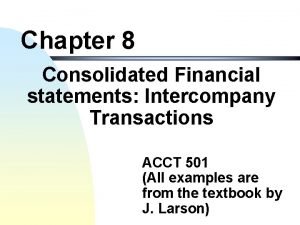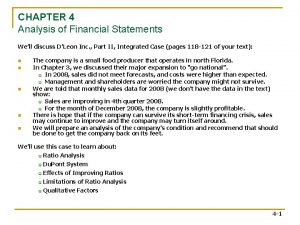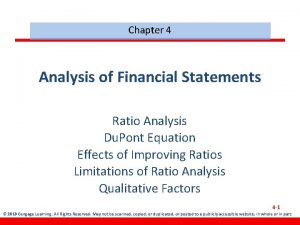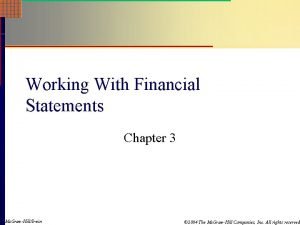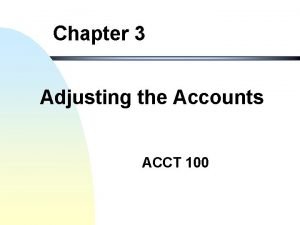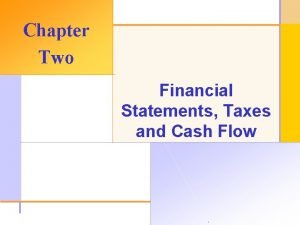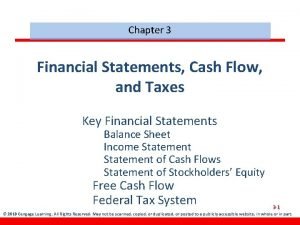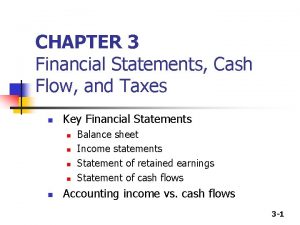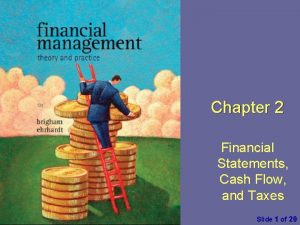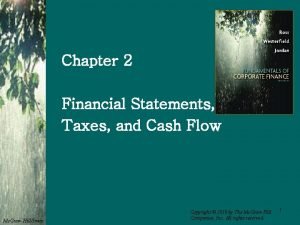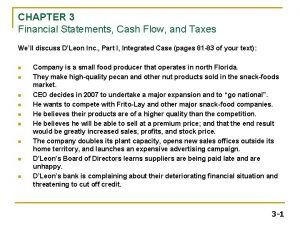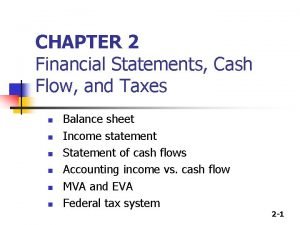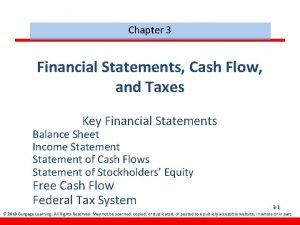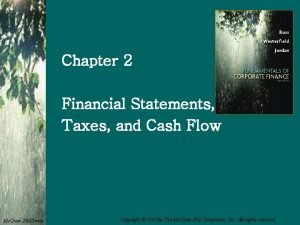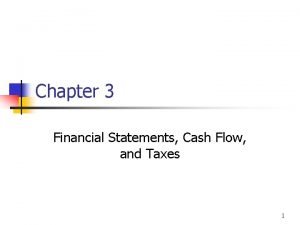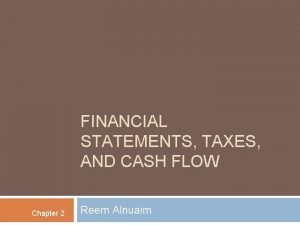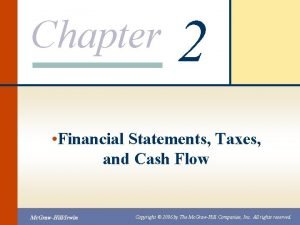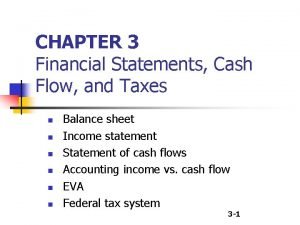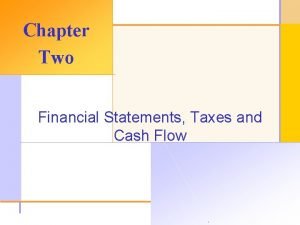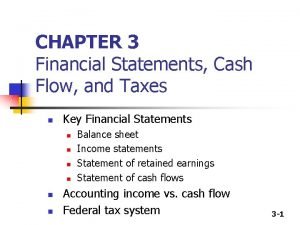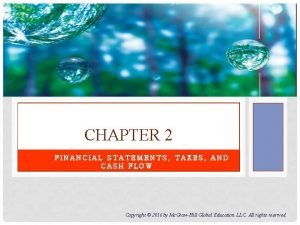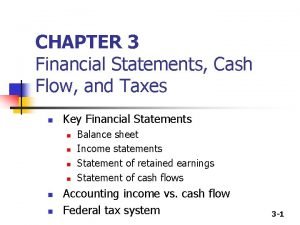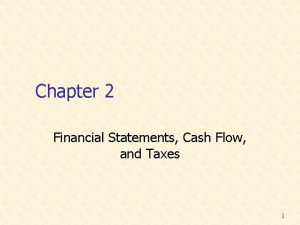Chapter 3 Financial Statements Cash Flow and Taxes






















- Slides: 22

Chapter 3 Financial Statements, Cash Flow, and Taxes 3 -1 © 2013 Cengage Learning. All Rights Reserved. May not be scanned, copied, or duplicated, or posted to a publicly accessible website, in whole or in part.

Importance of Understanding Accounting is the process of measuring, interpreting, and communicating financial information to support internal and external business decision making. Both internal and external people associated with a business need accounting information to make informed and calculated decisions. 3 -2 © 2013 Cengage Learning. All Rights Reserved. May not be scanned, copied, or duplicated, or posted to a publicly accessible website, in whole or in part.

Importance of Understanding Accountants prepare financial statements, while finance managers interpret and use them to maximize shareholder wealth. However, finance managers still need a good understanding of accounting. 3 -3 © 2013 Cengage Learning. All Rights Reserved. May not be scanned, copied, or duplicated, or posted to a publicly accessible website, in whole or in part.

The Annual Report All publicly traded companies must disclose yearly financial performance in a report called the “annual report”. • Balance sheet – provides a snapshot of a firm’s financial position at one point in time e. g. December 31, 2008. • Income statement – summarizes a firm’s revenues and expenses over a given period of time e. g. 2008. • Statement of cash flows – reports the impact of a firm’s activities on cash flows over a given period of time. • Statement of stockholders’ equity – shows how much of the firm’s earnings were retained, rather than paid out as dividends. 3 -4 © 2013 Cengage Learning. All Rights Reserved. May not be scanned, copied, or duplicated, or posted to a publicly accessible website, in whole or in part.

Balance Sheet • It is a summary of what the firm owns (assets) and how those assets were financed (liabilities and owners equity). • Assets are divided into two major categories: current assets and fixed, or long-term, assets. • Liabilities are also divided into – current and long term. • Stockholders’ equity can be calculated as: (i) Stockholders' equity = Paid in capital + Retained earnings (ii) Stockholders' equity = Total assets - Total liabilities 3 -5 © 2013 Cengage Learning. All Rights Reserved. May not be scanned, copied, or duplicated, or posted to a publicly accessible website, in whole or in part.

Balance Sheet (cont’d…. ) 3 -6 © 2013 Cengage Learning. All Rights Reserved. May not be scanned, copied, or duplicated, or posted to a publicly accessible website, in whole or in part.

Balance Sheet (cont’d…. ) 3 -7 © 2013 Cengage Learning. All Rights Reserved. May not be scanned, copied, or duplicated, or posted to a publicly accessible website, in whole or in part.

Balance Sheet (cont’d…. ) Working capital: A measure of both a company's efficiency and its short-term financial health. It is calculated as: 3 -8 © 2013 Cengage Learning. All Rights Reserved. May not be scanned, copied, or duplicated, or posted to a publicly accessible website, in whole or in part.

Net Operating Working Capital Net operating working capital = (10+375+615) – (60+140) = $800 million for 2008 3 -9 © 2013 Cengage Learning. All Rights Reserved. May not be scanned, copied, or duplicated, or posted to a publicly accessible website, in whole or in part.

Income Statement • Also known as the profit and loss statement • Reports the income earned over a given period of time - Usually prepared to report on one fiscal year - Can be prepared for a quarter of a year (3 months) or even a month • Reports expenses incurred in order to earn that income. • Shows sales, expenses and net profit for a given period. 3 -10 © 2013 Cengage Learning. All Rights Reserved. May not be scanned, copied, or duplicated, or posted to a publicly accessible website, in whole or in part.

Income Statement (cont’d…. ) 3 -11 © 2013 Cengage Learning. All Rights Reserved. May not be scanned, copied, or duplicated, or posted to a publicly accessible website, in whole or in part.

Income Statement (cont’d. . ) EBITDA is also an important consideration for analysts and managers. EBITDA for Allied = Sales revenue – operating costs without DA = $3000 -2616. 2 = $383. 8 3 -12 © 2013 Cengage Learning. All Rights Reserved. May not be scanned, copied, or duplicated, or posted to a publicly accessible website, in whole or in part.

Net Operating Profit After Taxes (NOPAT) • It is an estimate of what a company would earn if it didn't have any debt. • For companies which use leverage, NOPAT is an alternative measure for measuring operating efficiency NOPAT = EBIT (1 – Tax rate) From the income statement for 2008, NOPAT = $283. 8 (1 – 0. 40) = $ 170. 28 million 3 -13 © 2013 Cengage Learning. All Rights Reserved. May not be scanned, copied, or duplicated, or posted to a publicly accessible website, in whole or in part.

Statement of Cash Flows • Accounting profit may not reflect the cash flow reality facing the firm. • The statement of cash flows is the accounting report that shows how much cash the firm is generating, where cash is coming from and where it is going. • Analysts are very interested in the cash flow realities of the firm because they realize that accounting profit is often not available to manage to pay bills. 3 -14 © 2013 Cengage Learning. All Rights Reserved. May not be scanned, copied, or duplicated, or posted to a publicly accessible website, in whole or in part.

Statement of Cash Flows (cont’d…. ) 3 -15 © 2013 Cengage Learning. All Rights Reserved. May not be scanned, copied, or duplicated, or posted to a publicly accessible website, in whole or in part.

Statement of Cash Flows (cont’d…. ) • Sources of Cash - Any decrease in an asset - Any increase in a liability - Any increase in common stock - Any increase in retained earnings • Uses of Cash - Any increase in an asset - Any decrease in a liability 3 -16 © 2013 Cengage Learning. All Rights Reserved. May not be scanned, copied, or duplicated, or posted to a publicly accessible website, in whole or in part.

Statement of Stockholders’ Equity • It uses information from both the balance sheet and income statement. 3 -17 © 2013 Cengage Learning. All Rights Reserved. May not be scanned, copied, or duplicated, or posted to a publicly accessible website, in whole or in part.

Free Cash-flow (FCF) Free cash flow (FCF), is defined as “the amount of cash that could be withdrawn without harming a firm’s ability to operate and to produce future cash flows”. Free cash flow represents the cash a firm has generated for its shareholders, after paying its expenses and investing in its growth. FCF = [283. 8 (1 – 0. 40) + 100] – [230 + (800 -650)] = - $109. 7 million 3 -18 © 2013 Cengage Learning. All Rights Reserved. May not be scanned, copied, or duplicated, or posted to a publicly accessible website, in whole or in part.

What was the free cash flow (FCF) for 2012? Is negative free cash flow always a bad sign? It is important to note that negative free cash flow is not bad in itself. If free cash flow is negative, it could be a sign that a company is making large investments. If these investments earn a high return, the strategy has the potential to pay off in the long run. 3 -19 © 2013 Cengage Learning. All Rights Reserved. May not be scanned, copied, or duplicated, or posted to a publicly accessible website, in whole or in part.

Market Value Added (MVA) Since the primary goal of management is to maximize the firm’s stock price, we need to bring stock prices into the analysis. MARKET VALUE ADDED (MVA) Shareholder wealth is maximized by maximizing the difference between the market value of the firm’s stock and the amount of equity capital that was supplied by shareholders. This difference is called the Market Value Added. MVA = Market value of stock - Equity capital supplied by shareholders = (Shares outstanding)(Stock price) - Total common equity = (50, 000 * 23. 06) – 940, 000 = $213, 000 3 -20 © 2013 Cengage Learning. All Rights Reserved. May not be scanned, copied, or duplicated, or posted to a publicly accessible website, in whole or in part.

Income Tax System • • Individual Taxes Corporate Taxes Both have a progressive structure (the higher the income, the higher the marginal tax rate). • Interest paid: tax deductible for corporations (paid out of pre-tax income), but usually not for individuals. • • • Interest earned: usually fully taxable Dividends paid – paid out of after-tax income. Dividends received – taxed as ordinary income for individuals (“double taxation”). 3 -21 © 2013 Cengage Learning. All Rights Reserved. May not be scanned, copied, or duplicated, or posted to a publicly accessible website, in whole or in part.

© 2013 Cengage Learning. All Rights Reserved. May not be scanned, copied, or duplicated, or posted to a publicly accessible website, in whole or in part.
 Cffa finance formula
Cffa finance formula Cash flow to creditors is equal to
Cash flow to creditors is equal to Cash is current asset or not
Cash is current asset or not Ipsas 2 cash flow statements
Ipsas 2 cash flow statements Financial statements and ratio analysis chapter 3
Financial statements and ratio analysis chapter 3 Financial statements and ratio analysis chapter 3
Financial statements and ratio analysis chapter 3 Chapter 2 income benefits and taxes
Chapter 2 income benefits and taxes Chapter 14: taxes and government spending section 1
Chapter 14: taxes and government spending section 1 Section 4 best practices of successful people
Section 4 best practices of successful people Chapter 23 understanding income and taxes
Chapter 23 understanding income and taxes Chapter 14 taxes and government spending
Chapter 14 taxes and government spending Chapter 14 taxes and government spending
Chapter 14 taxes and government spending Cash-in cash-out
Cash-in cash-out Chapter 6 discounted cash flow valuation
Chapter 6 discounted cash flow valuation Adjusting accounts for financial statements chapter 3
Adjusting accounts for financial statements chapter 3 Chapter 9 financial statements for a sole proprietorship
Chapter 9 financial statements for a sole proprietorship Sole proprietorship financial statements
Sole proprietorship financial statements Adjusting accounts for financial statements
Adjusting accounts for financial statements Intercompany bond transactions
Intercompany bond transactions Chapter 4 analysis of financial statements
Chapter 4 analysis of financial statements Chapter 4 analysis of financial statements
Chapter 4 analysis of financial statements Working with financial statements chapter 3
Working with financial statements chapter 3 Chapter 3 adjusting accounts for financial statements
Chapter 3 adjusting accounts for financial statements

